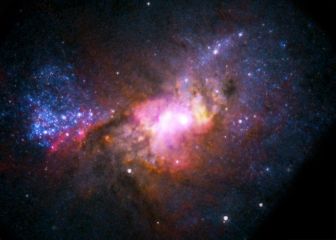Shedding light on dark matter
The search for dark matter—the mysterious substance that accounts for 85 per cent of the mass of the universe—has dominated cosmology for many decades. With the help of UVic researchers, that search may soon come to an end.
More than 75 years ago, scientists inferred the existence of dark matter from its gravitational effects. Most cosmologists believe that dark matter is a new kind of elementary particle yet to be detected on Earth. It’s possible that this particle will be detected in experiments at the Large Hadron Collider (LHC) at CERN in Switzerland, once it is operational in the new year. University of Victoria particle physicists and computer scientists have been instrumental in the creation of the ATLAS particle detector at the LHC and the international computer network that will analyze the massive amounts of data created by the collider.
On an intergalactic scale, evidence for dark matter has remained stubbornly invisible to astronomers’ telescopes. But research by an international team of astronomers including UVic’s Dr. Julio Navarro is providing direction on where best to point NASA’s FERMI satellite telescope in the search for the telltale gamma radiation signature of dark matter. They published their most recent results in the Nov. 8 issue of Nature.
“There is a tremendous sense of anticipation in the astrophysics community that we may be within a few years of solving one of the main outstanding puzzles in our understanding of the universe: the nature of dark matter,” says Navarro. “Our computations provide a clear blueprint for searching for an unambiguous signal from dark matter in the data collected by FERMI.”
Called the Virgo Consortium, the team of astrophysicists used one of Europe’s largest supercomputers to simulate the formation of the dark matter halo structure that surrounds a galaxy like our own Milky Way. Gamma rays are produced in such regions of high dark matter density when the particles collide and annihilate each other in a puff of radiation.
The computer simulation took 3.5 million pro-cessor hours to complete and showed that by far the most easily detectable gamma ray signal should come from regions 10 to 30 degrees from the centre of the Milky Way. Previously, cosmologists had argued that the Milky Way’s satellite galaxies, such as the Large and Small Magellanic Clouds, would be the ideal place to search for gamma rays, since their centres should be very dense.
The Virgo Consortium involved scientists from UVic, the Max Planck Institute for Astrophysics in Germany, the Institute for Computational Cosmology at the University of Durham in the UK, the University of Massachusetts and the University of Groningen in The Netherlands.

